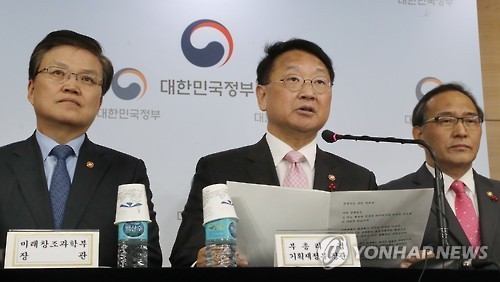South Korea on Thursday cut its economic growth forecast by 0.4 percentage point to 2.6 percent for next year, as a slight recovery in exports will be offset by a slowdown in domestic demand.
It also revised down its earlier estimate for 2016 to 2.6 percent from 2.8 percent as stronger-than-expected downside risks such as partial strikes at major carmakers weighed heavily on Asia's fourth-largest economy in the fourth quarter.
 |
South Korea's Finance Minister Yoo Il-ho speaks at a press briefing in Seoul on Dec. 29, 2016. (Yonhap) |
In the 2017 policy plan unveiled at a ministerial meeting in Seoul chaired by Acting President Hwang Kyo-ahn, the government said it will take more expansionary fiscal policy to spur growth and prepare to deal with future external and internal drags.
Other public and private institutions have already made downward revisions of their own growth estimates.
The state-run Kore Development Institute predicted that Asia's fourth-largest economy will grow 2.4 percent in 2017, sharply down from its earlier forecast of 2.7 percent, while the Korea Economic Research Institute downgraded its estimate by 0.1 percentage point to 2.1 percent and Japanese investment bank Nomura said South Korea will likely grow 2 percent next year.
The Organization for Economic Cooperation and Development also cut its 2017 growth forecast for the South Korean economy to 2.6 percent from 3 percent.
The Bank of Korea, who holds an outlook of 2.8 percent, will take similar action in January.
The government said the 2.6 percent forecast is its target growth for next year amid rising uncertainties in the world economy stemming from the scheduled government change in the United States and a further rate hike by the US central bank.
"We expect fiscal interventions to push up the growth by 0.2 percentage point next year," Lee Ho-seung, a director general at the Ministry of Strategy and Finance, said in a press conference which was held in advance in Sejong. "We set the 2.6 percent growth forecast to show the government's policy determination to reach the target of 2.6 percent."
The government predicted that private consumption will likely expand 2 percent next year, slowing down from 2.4 percent for 2016, on contracted real income and mounting household debt, which already surpassed 1,300 trillion won.
Along with construction investment, consumption was one of the main contributors to the 2.6 percent growth for the entire economy in 2016, when exports fell 6.1 percent and facility investment retreated 3.3 percent.
Exports will make a turnaround to gain 2.9 percent next year on the back of a recovery in world trade and rising demand for chips and displays, while imports will jump 7.2 percent on a gain in oil prices.
As a result, the trade surplus is expected to contract to $8.2 billion from $9.4 billion in 2016.
Consumer prices will likely go up 1.6 percent next year as a rise in oil prices will fuel inflation at a faster pace than 2016's 1 percent.
"It is worrisome that the recovery momentum will lose steam as domestic demand, which has backed the economy so far, slows down amid a protracted slump in exports," the finance ministry said.
"The government will strengthen policy efforts to put the economy on the right track before the end of the first quarter."
The government will spend some 70 percent of the 400.5 trillion won budget for 2017 to pump prime the economy from the beginning of the year and map out a supplementary budget before the end of June if necessary.
In line with the plan, the government will inject an additional 20 trillion won in the first half, including 8 trillion won in corporate loans from state-run policy lenders and 7 trillion won in public investment into new emerging industries.
To boost consumption, the government will give a 70 percent cut in excise tax to those who replace their old diesel cars with new one, and expand the Korea Sale Festa, the nationwide shopping festival, to attract more shoppers and foreign visitors.
It will also build cruise docks in the country's main maritime gateways to reach the target of 2 million cruise tourists next year, while electronic visas will be issued to tourist groups from Southeast Asian countries.
The government also came up with measures to control the household debt in preparation for a future rate hike by the BOK in accordance with the US central bank's monetary tightening next year.
Toughened screening of borrowing qualifications will be expanded to all types of mortgage loans and all local lenders have to increase the share of fixed-rate, amortizing loans in the government-led loan conversion program.
Along with policies to create jobs for young people, the minimum wage will increase 7.3 percent on-year to 6,470 won per hour to provide better labor treatment to young job seekers and part timers.
The public sector will newly employ 60,000 people next year to ease the tightened job market, and employers who give full-time jobs to young workers will be given expanded tax breaks.
In order to solve the chronic low birth rate and late marriage trend, the government will expand tax and financial incentives for married couples and raise maternity leave allowances to 1.5 million won from 1.35 million won.
To join the fourth industrial revolution in a timely manner, the government will create a public-private governing body which spearheads the policy-making process covering the sectors of economy, education, technology and industry. (Yonhap)








